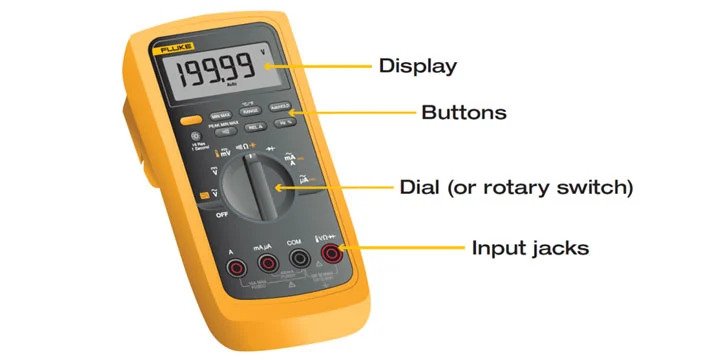A fluke multimeter is an excellent tool for any electronics enthusiast. It can measure voltage, current, and resistance, making it a valuable asset for troubleshooting and repairing electronic equipment. The best thing about a fluke multimeter is that it is user-friendly and easy to use.
Even if you have never used one before, you should be able to get the hang of it quickly.
What is a Fluke Multimeter Used For?
A fluke multimeter is a device that measures electrical voltage, current, and resistance. It can also measure temperature, capacitance, and frequency. Multimeters are used in various applications, including troubleshooting electrical problems, testing circuit breakers and fuses, and measuring AC or DC voltage levels.
Here is a list of some common uses for a multimeter
- Testing continuity: Fluke used to test whether an electrical circuit is complete or not by measuring the resistance between two points in the circuit.
- Measuring voltage: Fluke multimeter ideal to measure the voltage of an electrical circuit or device by connecting the meter in parallel with the circuit or device.
- Measuring current: To measure the current flowing through an electrical circuit or device by connecting the meter in series with the circuit or device.
- Measuring resistance: Measure the resistance of an electrical component or circuit by connecting the meter in parallel with the component or circuit and measuring the voltage drop across it.
- Testing diodes: Test the functioning of a diode by measuring the voltage drop across it in both the forward and reverse directions.
- Testing transistors: Test the functioning of a transistor by measuring the voltage drop across it in both the forward and reverse directions, as well as measuring the current flowing through it.
- Testing switches: A multimeter can be used to test the functioning of a switch by measuring the resistance between its terminals when it is open and closed.
- Troubleshooting electrical issues: Fluke multimeter used to diagnose and troubleshoot electrical issues by measuring various electrical quantities and comparing them to expected values.
Step-by-Step Guide to Using a Fluke Multimeter for Accurate Electrical Measurements

You may have questions about how to use a fluke multimeter. After all, this is not your everyday tool. But don’t worry, we’re here to help.
In this blog post, we’ll walk you through everything you need to know about using a fluke multimeter to test a fuse.
Step -1
First, familiarize yourself with the different parts of the multimeter. It should have a display screen, a rotary dial or buttons for selecting the measurement mode, and several probes or leads for making connections to the device or circuit being tested.
Step -2
Select the appropriate measurement mode on the multimeter. For example, select the “V” (for volts) mode if you want to measure voltage. If you want to measure resistance, select the “Ω” (omega) mode. Consult the user manual if you are unsure which mode to use for a particular measurement.
Step -3
Make sure the multimeter is set to the correct range for the type of measurement you are taking. For example, if you are measuring voltage, you may need to select a range of 0-15V or 0-30V, depending on the expected voltage of the circuit.
Step -4
Connect the probes or leads to the appropriate points on the device or circuit. The positive (red) probe should be connected to the positive terminal or lead, and the negative (black) probe should be connected to the negative terminal or lead. In some cases, you may need to use the common (usually marked “COM”) terminal on the multimeter as a reference point.
Step -5
Take the measurement by touching the probes or leads to the appropriate points on the device or circuit. The display screen should show the measured value in the selected units.
Step -6
If the measured value is outside the expected range, check the connections and the measurement mode and range settings on the multimeter. Make sure the probes or leads are securely connected and not touching each other or any other conductive surfaces.
Step -7
Repeat the measurement as needed to obtain an accurate reading. Some measurements, such as resistance, may require you to apply a known voltage to the circuit and then measure the resulting current. Consult the user manual for specific instructions on how to perform these types of measurements.
Step -8
When finished, turn off the multimeter and disconnect the probes or leads from the device or circuit. Store the multimeter in a safe place, making sure the probes or leads are properly stowed and not damaged.
Watch the Video: How To Use A Fluke Multimeter Basic Functions
Are Fluke Multimeters Worth It?
There are a lot of different factors that go into whether or not a Fluke multimeter is worth the investment. For one, Fluke multimeters are known for their accuracy and reliability. This means you can trust the readings you get from a Fluke multimeter, which is important when working with sensitive equipment or making critical measurements.
Another factor to consider is the features offered by Fluke multimeters. Many models have built-in features that make them more versatile and easier to use than other brands. For example, some models include backlighting, auto-ranging, and data logging.
These added features can make using a Fluke multimeter much more convenient, especially in difficult or challenging environments. Finally, it’s also worth considering the customer support offered by Fluke. The company has an excellent reputation for providing helpful and responsive customer service.
This means that if you have any problems with your Fluke multimeter, you can rest assured knowing that you’ll be able to get help from a knowledgeable and friendly customer service representative.
All things considered, there are plenty of good reasons to invest in a Fluke multimeter. If accuracy, reliability, versatility, and customer support are important to you, then a Fluke multimeter is definitely worth considering.
Watch The Video – How To Select the Right Multimeter | Fluke Pro Tips
How do I select the measurement mode on my Fluke multimeter?
To select the measurement mode on a Fluke multimeter, use the rotary dial or buttons on the front of the device. Consult the user manual for specific instructions on how to select the appropriate mode for the type of measurement you want to take.
How do I know which range to select for my measurement?
The range of a Fluke multimeter determines the maximum value that can be accurately measured. To select the appropriate range, consult the user manual or the markings on the device itself. In general, it is best to select the lowest range that is capable of measuring the expected value of the circuit or device you are testing.
Can a Fluke multimeter be used to test AC or DC voltage?
Yes, most Fluke multimeters are capable of measuring both AC and DC voltage. To switch between AC and DC mode, consult the user manual for specific instructions. Some multimeters may have a dedicated AC/DC button or switch, while others may require you to select the appropriate mode using the rotary dial or buttons on the front of the device.
Can a Fluke multimeter be used to test resistance?
Yes, many Fluke multimeters are capable of measuring resistance. To do so, select the “Ω” (omega) mode on the multimeter and connect the probes or leads to the appropriate points on the circuit or device being tested. The measured resistance will be displayed on the screen in ohms (Ω).
Can a Fluke multimeter be used to test continuity?
Yes, most Fluke multimeters are equipped with a continuity testing feature. To test for continuity, select the appropriate mode on the multimeter (usually indicated by a symbol of a sound wave or a buzzer). Touch the probes or leads to the points on the circuit or device being tested. If there is a continuous path between the two points, the multimeter will emit a sound or tone to indicate continuity.
How do I properly store my Fluke multimeter?
When storing your Fluke multimeter, make sure to turn it off and disconnect the probes or leads from any devices or circuits. Store the multimeter in a safe, dry location out of the reach of children or pets. Make sure the probes or leads are properly stowed and not damaged or bent. Consult the user manual for specific instructions on how to care for and maintain your multimeter.
Conclusion
If you’re looking to learn how to use a Fluke multimeter, this blog post is for you. It covers everything from the basics of what a multimeter is and how it works, to more advanced topics like how to troubleshoot electronic circuits.
You’ll also find helpful tips on things like choosing the right model for your needs and taking care of your multimeter.


